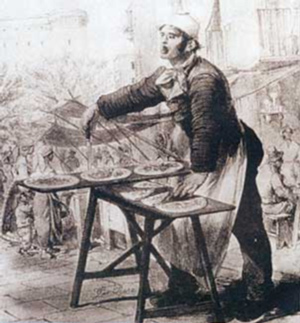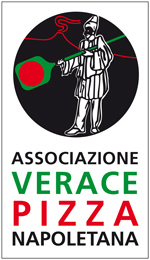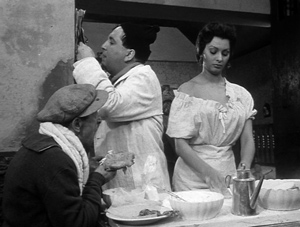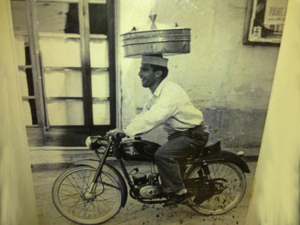The pizza is an icon of Italian food in the world, though it has never been just pizza, but a glue and a bridge between social classes, ethnic groups, peoples and cultures.
To facilitate its diffusion has played a fundamental role the Association Verace Pizza Napoletana, thanks to its founder Antonio Pace and Lello Surace
whom I thank from my heart for what they do as far back as 1984.
Here is a small description of what this important fact of which I am proudly part.
The
True Neapolitan Pizza Association (Associazione Verace Pizza napoletana,AVPN) is a non-profit organization and was
founded in June 1984 in Naples with its legal and operational headquarters.
Its mission is to promote and protect in Italy and worldwide the "true Neapolitan pizza" ("verace pizza napoletana"),
i.e. the typical product made in accordance with the characteristics described in
the International Regulations for obtaining a
collective brand mark "True Neapolitan Pizza" ("Vera Pizza Napoletana"), in force since 1984, edited and registered by AVPN.
The Association is also involved in the promotion and protection of the affiliated pizzerias and products related to the production filer of
"true Neapolitan pizza" and in the professionalization of pizza makers.
The history of pizza
When mankind started farming, a discovery was made: wheat and other crops could be "pulverized" (made into flour) and,
with the addition of water, turned into a dough, which could then be formed and cooked on hot stones.
This is how a rudimentary form of pizza began.
Now, it is impossible to reconstruct the exact history of pizza; many peoples made elementary versions, but the purpose of this chapter is not to try to identify them.
Here, we limit ourselves to research which has uncovered some references in ancient texts to what today we call pizza, and to some hypotheses and anecdotal evidence.
Our clients are generally curious and entertained by the many theories of the origins of pizza and, indeed, most of us would like to know something about how such a popular dish
came to be invented. The ancient Egyptians certainly made food that was an ancestor of pizza, by cooking dough made from ground cereals and water, with the addition of herbs and spices.
The ancient Egyptians used aromatic herbs on religious occasions and are thought to have discovered the leavening process, possibly by mistake, by cooking a dough that had
been left unattended and had begun to grow in size and to turn acidic.
The result was actually better - tastier and with a better aroma - than cooking fresh dough.
The fortunate baker who stumbled on the process was probably very successful. Whatever the truth of the matter, leavening led to the production of bread, focaccia and pizza.
There are records of how the Ancient Egyptians cooked pizza, in metal jars (perhaps copper), the dough spread over the inner surface, with a flame inside the jar.
When the dough peeled away from the metal it was ready.
Much later, the Romans inherited many recipes and legends from the Greeks. One of the stories handed down was that of Demeter, goddess of corn and agriculture,
who taught the prince of Eleusis how to bake pizza and made him the cook on Olympus.
The Romans certainly baked bread and it appears that the centurions ate their meals on discs of bread which were used as plates.
Perhaps this was the first genuine kind of pizza. One of the most amusing and imaginative anecdotes relating to the Roman times is the story of how focaccia was invented
after one of the proverbial betrayals by the goddess Venus of her husband Vulcan.
Late, after a meeting with her lover, she needed to make a quick meal for Vulcan, due to return from the forge inside Mount Vesuvius. Hurriedly, she made a dough of water and flour,
cooked it on hot stones and served this focaccia to Vulcan, who liked it so much she was obliged to make it every day and therefore was unable to return to her amorous pursuits.
Certainly, pizza has been made for thousands of years throughout the Mediterranean area, but it was in Naples, at the foot of Mount Vesuvius, that modern pizza was first created.
The taverns with ovens used discs of dough to clean them and control their temperature, and this dough was then sold to people who could afford nothing better.
Subsequently, these "pizzas" were sold outside the tavern or in the streets.
Like today, they were seasoned with basil, lard and seasoned cheeses (mastunicola), anchovies or tomatoes. Tomatoes had been discovered in the Americas in the sixteenth
century and were initially used as an ornamental plant in private gardens, the fruit being considered poisonous.
In 1544, Pietro Mattioli classified it with other poisonous plants and it was not until much later that it was used for cooking throughout the Mediterranean.
It was thought to be an aphrodisiac until the end of the seventeenth century and was used by alchemists for their potions.
Towards the end of the eighteenth century, people began writing about tomatoes for cooking in southern France and southern Italy,
whilst elsewhere in France it remained a niche product for royalty and the aristocracy.
At that time, in Naples and the rest of southern Italy, pizza was already very popular, particularly among the ruling classes.
In the mid-eighteenth century, Ferdinando di Borbone, King of Naples, (the dynasty featured in the cartoon film Totò sapore,
narrating the history of pizza) visited a pizza-maker in town, immediately conferring fame and fortune on the shop and its coveted product.

The King was so fond of pizza he introduced it at court but his wife snubbed it as a vulgar imitation of popular culture.
His successor, Ferdinando II, had better luck, managing to have pizza ovens installed in the royal household. Soon pizza was a regular court dish.
Of course, it was a popular product in the taverns and shops of Naples, but the approval of royalty certainly gave it greater popularity in aristocratic circles,
and shops soon sprung up making nothing but the "king's favourite dish". Popularity in the media came with the rulers from the House of Savoy, King Umberto I and Queen Margherita,
who took up their summer residence in Naples at the end of the nineteenth century and tasted pizza for the first time.
On that occasion, the pizza was made by the pizzaiolo Raffaele Esposito, who recommended a Mastunicola, with lard, seasoned cheese and basil, Marinara, with tomato, garlic,
oregano and olive oil (called a "marinara" because its ingredients could be kept for a long time and hence were often taken on long sea voyages) and a pizza with tomato, mozzarella and basil,
often said to have been invented by the pizza-maker's wife to represent the colours of the new Italian flag but in fact already a popular pizza.
The truth is the pizza took its name from the Queen, consolidating the tradition of Neapolitan pizza,
which continues to this day, despite the fact that pizza is now made the world over, using a variety of techniques.
It has become the Italian dish, appreciated by everyone, irrespective of social standing or origin.
It is estimated that about 9 million pizzas are made every day in Italy alone, a business worth around 5.3 billion Euros,
at an average cost of € 5.90 (data from the Italian Federation of Shopkeepers - Confederation of Commerce).
Its popularity the world over began at the end of the nineteenth century, with the emigration of millions of Italians, above all to the U.S.A. Full of hope for the future
but with their own strong traditions, the new arrivals came with their own gastronomy.
The first American pizzeria opened in Little Italy in 1905, and spread like wildfire throughout the country, so fast indeed that many Americans are convinced that pizza originated in the US.
Rapidly and worldwide, pizza became a quick, cheap dish and complete meal, with an average consumption in the USA, for example, of 13 kg. per person per year, almost double the average
consumption in Italy.
The Form of Pizza
Today, pizza comes in a number of shapes and sizes: spherical, rectangular, triangular (fried), even square (trademarked and frozen, marketed in boxes).
It is sold direct from ovens and transported with small heaters in Naples, for example, or delivered in boxes with brand names.
In Naples, pizza is a disc of dough, traditionally not round; in Rome it is rectangular, thin and crisp; in India chapati is made of water and flour and varies according to how it is cooked.
In America, pizza has become big business, with high consumption, a massive turnover, and many franchised trademark stores such as Pizza Hut, Domos Pizza and others.
A recent market survey has shown that most Americans believe they invented pizza... a blow to Italy's self-esteem,
which for at least two centuries has been partly based on its well-documented invention of pizza.
Every region and territory has its own history of pizza, and has re-interpreted the centuries-old, oven-baked food invented (knowingly or by accident) for mere sustenance and developed for pleasure.
With globalization, pizza has become a worldwide product, known to all, eaten regularly by many, appreciated practically universally.
Once a quintessentially Italian product, now it more like a painting by Monet: undefined, without a single shape or form, almost abstract, technically extremely accomplished.
Its techniques and history have roots almost everywhere, close to the surface in New York, very deep in Naples; they include simple pizza with lard and mozzarella,
as well as US-style pizza Diavola with peppers and sausage, which can be found on practically every pizzeria menu the world over.
Strange but true
« Alexandre Dumas, the author of The Three Musketeers, arrived in Naples in 1835, and wrote: "Pizza is a little like something round they make in Saint Denis from the same dough as bread. (...) At first it seems very simple, but look closer and you discover it is a complicated dish. (...) Pizza with oil, lard, pork fat, tomatoes, small fish. It is the gastronomic thermometer of the market: it increases or decreases in price according to the ingredients and their freshness. »
NATO declares war on pizza:
Pizzerias and fast food restaurants are prohibited near bases because soldiers become distracted from their military functions by pizza .... Pizza as a weapon of peace?
During his term in office, Nicolas Sarkozy had a pizza oven installed on the Presidential plane ..... Not bad for take-away pizza!
In Trieste a couple was eating a pizza in the park when they were attacked by a giant boar, attracted by the aroma of the pizza. After gobbling it down, the wild animal wandered off, leaving the frightened couple in peace.
Una pizza bestiale...
As the First Lady fights a battle against childhood obesity, US President Barack Obama has been honoured by a supporter in Colorado, who has dedicated a new pizza to him.
Salami, sausage, peppers, onions and black olives: these are the ingredients of the "Potus" pizza, an acronym for the President of the United States. Obama quipped to some University students on campus that he was "deeply moved" by the honour.
London - (Internet) - We have no idea whether it is true, but on Internet there are rumours that Claire Simmons of London, 33, has eaten nothing but pizza with tomato and cheese for the past 31 years. The doctors have told her the rather restricted diet could kill her. She says she has no memory of ever eating anything else. "I keep healthy with plenty of water. But my doctor says I will have problems as I get older due to the lack of vitamins and minerals", says Claire, who declares that she is too frightened of fruit and vegetables to eat them.
"Pizza Brain", the first museum dedicated to pizza opens in Philadelphia.
Fishtown (USA) - Life is strange: we Italians are known the world over for pizza, but the first museum dedicated to this food has opened not in Italy but in the USA, in Philadelphia to be precise. The idea came to Brian Dwyer, who features in the Guinness Book of Records as the world's top collector of pizza-related items. Made famous by inclusion in the book, he decided to turn his hobby into a full-time job, found a backer and with some friends opened "Pizza Brain", the world's first pizza museum.
Of course there are museums for the strangest things, but a pizza museum probably beats the record of extravagance. More seriously, wouldn't the best place for a pizza museum be in the country that invented it?





